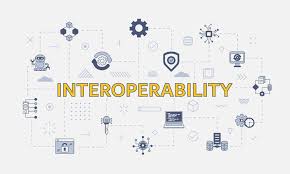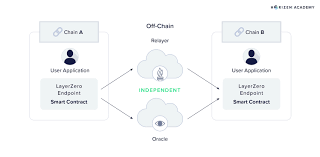Interoperability Between Different Blockchains

Introduction: the problem of blockchain silos
One of the most important challenges in the blockchain industry today is the lack of interoperability . While blockchains like Bitcoin, Ethereum, Binance Smart Chain, and Solana each offer unique features, they mostly operate in isolation. This is what many call “blockchain silos” – separate ecosystems that cannot exchange information or assets locally . For example, a bitcoin transaction cannot communicate directly with the Ethereum smart contract, and the Solana – based application cannot seamlessly use the data of the Binance smart chain .
This lack of connection limits the development of decentralized applications (DApps), financial products and real-world use cases. In a world where businesses, governments and individuals increasingly rely on multiple blockchains, interoperability is becoming essential. Without it, the blockchain risks scattering, reducing efficiency, adoption and innovation.
Why interoperability matters to the blockchain industry
Interoperability is more than just technological improvements; it is the basis of a unified digital economy. Imagine whether emails only work between users of the same provider, or if the internet is divided into separate, non-communication networks. This is exactly the situation facing the blockchain industry today .
Cross-chain transactions: customers want to move assets from one blockchain to another without relying on Central exchanges.
Decentralized finance (DeFi) development: a lending protocol on Ethereum should be able to use collateral from bitcoin or polygon smooth.
Enterprise adoption: businesses are reluctant to use the blockchain if they only have to choose one ecosystem. Interoperability allows them to connect different platforms for Supply Chain Management, Payments, or compliance.
User experience: end users should not need to know what blockchain their assets are on . Interoperability can make the blockchain as smooth as using the internet.
Thus, interoperability is not just a technological luxury – it is the need for mainstream adoption of blockchain technology.
Current challenges hampering blockchain interoperability
Although interoperability seems simple, there are several obstacles to preventing smooth cross-chain communication:
Different consensus mechanisms: bitcoin uses proof of work, Ethereum is the transition to proof of stakes, while others like Solana use proof of history. This makes it difficult to verify synchronization and trust in blockchains .
Different programming languages: Ethereum uses solidarity for smart contracts, while Cardano uses Plutus, and Polkadot supports rust. These differences complicate standardization .
Security risks: interoperability solutions often rely on bridges and third-party protocols. Unfortunately, many cross-chain bridges have been hacked, resulting in billions of dollars in damage.
Scalability issues: data transfer to blockchains often introduces delays, higher fees, or interruptions, worsening the user experience.
Regulatory concerns: cross-chain transactions can complicate compliance with regulations such as KYC (Know Your Customer) and AML (anti-money laundering), as tracking assets becomes more complicated.
Overcoming these challenges is critical to building a safe and effective multi-chain future .
Key solutions for blockchain interoperability
1. Cross Chain Bridge
Cross-chain bridges allow users to transfer assets from one blockchain to another. For example, wrapped bitcoin (WBTC) enables bitcoin to be used on Ethereum’s DeFi applications . However, while Bridges are popular, they remain prone to hacks, as shown in the infamous Ronan bridge hack (2022), which is valued at more than 6 600 million.
2. Side chains
Side chains are independent blockchains that run parallel to a central chain. They allow assets to move between chains while maintaining security and speed. For example, the Polygon acts as a sidechain for Ethereum, offering faster and cheaper transactions.
3. Projects focused on interoperability
Polkadot: built specifically for interoperability, it uses a central relay chain that connects multiple parachinas, allowing them to interact seamlessly.
Cosmos: uses its interblockchain communication (IBC) protocol to allow different blockchains to effectively transfer data and assets.
Quant Network: focuses on providing an operating system (overlayer) that connects multiple blockchains to adapt to the enterprise.
4. Nuclear exchange
Nuclear exchanges allow peer-to-peer cryptocurrency exchanges between different blockchains without the need for mediators. This ensures untrustworthy and decentralized interoperability, although adoption has slowed due to technical complexity .
Real-world applications of blockchain interoperability
1. Decentralized finance (DeFi )
DFI relies heavily on interoperability. Imagine a lending platform that accepts bitcoin as collateral but works on Ethereum smart contracts-interoperability makes this possible . Multi-chain DeFi protocols such as Curve Finance and Aave are already looking for such models.
2. Supply chain management
Global supply chains include multiple stakeholders using different blockchain systems . Interoperability allows a logistics company to exchange data with a retailer using VeChain using IBM’s Hyperledger, ensuring transparency across the entire supply chain.
3. Health care systems
Secure medical records on various blockchain platforms need to be shared securely between hospitals, insurance companies and patients. Interoperability enables the exchange of health data related to privacy protection while maintaining compliance with regulations such as hipaa.
4. Central bank digital currencies (CBDCs )
As countries produce their own CBDC, interoperability will be necessary for cross-border payments. Without it, cbdcs are at risk of isolation, just like early blockchains. Initiatives such as Project Dunbar of the bank for International Settlements are already testing multi-CBDC interoperability.
The role of standardization in achieving interoperability
Standardization plays a key role in connecting blockchains . Organizations such as the Enterprise Ethereum Alliance (EEA) and ISO/tc 307 are working to create global blockchain standards. These efforts focus on aligning smart contract design, data structure and security practices, enabling different blockchains to communicate without custom-built solutions.
Security concerns in interoperable systems
While interoperability brings enormous benefits, it also introduces risks . The majority of DeFi hacks in recent years have targeted cross chain bridges highlighting the need for:
Strong auditing and testing of smart contracts
Decentralized bridge endorsers rather than central guards
Adopting zero knowledge-proof (ZKPs) for more secure cross-chain communications
Security must evolve alongside interoperability to protect customers and assets.
Vision of the future: a multi-chain world
The future of blockchain will not be dominated by a single chain but by a multi-chain ecosystem where different blockchains specialize in unique functions but are still connected. Ethereum could remain Solana’s hub for smart contracts, bitcoin for value storage, and fast transactions-all connected together by interoperability solutions.
As Web3, DeFi, NFTs, and Metaverse expand, consumers will demand seamless cross-chain experiences. The winners in this space will be protocols and businesses that successfully develop secure, user-friendly, and scalable interoperability solutions.
Result
Interoperability is the bridge that will transform the blockchain from fragmented networks into a unified digital ecosystem. By enabling cross-chain transactions, shared applications and global connectivity, interoperability paves the way for large-scale adoption of finance, supply chains, healthcare and beyond.
While challenges remain-from technical barriers to security threats-the progress of projects such as Polkadot, cosmos and quant shows that a truly connected blockchain future is possible. Ultimately, the success of blockchains depends not on isolated chains but on how effectively they work together.






